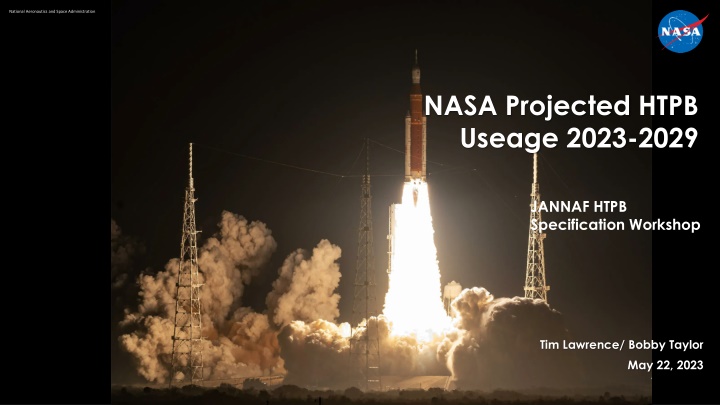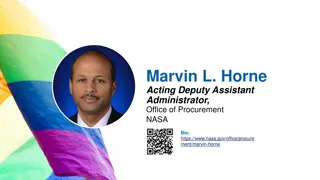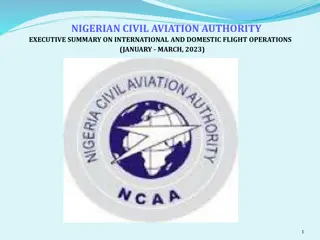HTPB Usage in NASA and Space Force Flights: Trends and Impacts
Analysis of NASA's projected HTPB usage from 2023 to 2029, focusing on the transition to HTPB boosters, impact on the polymer market, comparison of SLS and BOLE boosters, propellant development details, and HTPB polymer usage in NASA and Space Force flights.
Download Presentation

Please find below an Image/Link to download the presentation.
The content on the website is provided AS IS for your information and personal use only. It may not be sold, licensed, or shared on other websites without obtaining consent from the author.If you encounter any issues during the download, it is possible that the publisher has removed the file from their server.
You are allowed to download the files provided on this website for personal or commercial use, subject to the condition that they are used lawfully. All files are the property of their respective owners.
The content on the website is provided AS IS for your information and personal use only. It may not be sold, licensed, or shared on other websites without obtaining consent from the author.
E N D
Presentation Transcript
National Aeronautics and Space Administration NASA Projected HTPB Useage 2023-2029 JANNAF HTPB Specification Workshop Tim Lawrence/ Bobby Taylor May 22, 2023
Background May 22, 2023 Slide 2 Beginning in 2032, SLS Boosters will make the transition from PBAN to HTPB This change could have a large impact on the HTPB polymer market both in price and specifications First flight of BOLE is scheduled for 2032, however between 2023 and 2029 seven motor loadings are planned NASA also utilizes HTPB motors for Booster Separation and Launch Abort for each SLS flight Commercial Crew also uses HTPB boosters (AJ60 and GEM 63) and will transition to GEM63XL HTPB usage across the large solid rocket motor industry is projected to significantly grow during this time period due to new programs Vulcan(GEM63XL), Sentinel, GBI, BOLE
Comparison of SLS and BOLE May 22, 2023 Slide 3 SLS Booster Forward Skirt & Avionics: Heritage nose cone & skirt SLS Avionics Heritage BSM Placement Motor Performance: 3.6Mlbf Thrust, 1015 psi MEOP 5 Segment PBAN Propellant PBI-NBR Insulation Heritage D6AC Steel Cases Aft Skirt & Nozzle: ENKA Material for Nozzle Natural Rubber Flex Bearing Heritage Shuttle Hydraulic TVC Hydrazine-driven APU (>+3mT to TLI) BOLE Booster Forward Skirt & Avionics: Integral nose cone & frustum Modified SLS Avionics More capable forward skirt Optimized BSM Placement Motor Performance: 4.2Mlbf Thrust, 1330 psi MEOP 5 Segment HTPB Propellant AFEPDM + PBI-NBR Insulation T1100 Composite Cases Aft Skirt & Nozzle: ENKA Material for Nozzle Silicone Elastomer Flex Seal Battery-driven EHA TVC Thermal or Li-Ion Batteries
Propellant Development May 22, 2023 BOLE Propellant is HTPB, 88% solids with R45M polymer binder Slide 4 R45M will be procured per Northrop Grumman internal specification S273017 BOLE motor contains ~150klbs of R45M Motor Estimated Purchase Date Quantity (klbs) DM-1 2022 150 DM-2 2023 150 DM-3 2024 150 QM-1 2025 150 QM-2 2026 150 EM-9 2027 300
HTPB Polymer Usage in NASA and Space Force Flights May 22, 2023 Slide 5 BOLE igniter will use BSM HTPB propellant Quantities insignificant for both systems at two igniters (~50 lbs) and ten BSM s (~150 lbs) per flight set Launch Abort System for Orion utilized HTPB in the Jettison Motor and the Abort Motor Estimate 100 lbs of polymer per Jettison Motor Estimate 560 lbs of polymer per Abort Motor Commercial Crew will be using GEM63 Estimate up to 19,500 lbs of polymer per launch (based on two boosters) Space Force will be using Vulcan (GEM63XL) Estimate up to 60,000 lbs of polymer per launch (based on six boosters)
Summary May 22, 2023 SLS Booster will purchase R45M per commercial specification at 150klbs per year beginning in 2022, increasing to 300 klbs per year in 2028 Slide 6 NG is carrying a risk for R45M lot variability Will be assessed as we move forward Total SLS, Commercial Crew and Space Force motors using HTPB is significant and a driving case for production One Flight of SLS uses 300,643 lbs of HTPB One Flight of Commercial Crew uses 19,500 lbs of HTPB One Flight of Vulcan can use up to 60,000 pbs of HTPB























